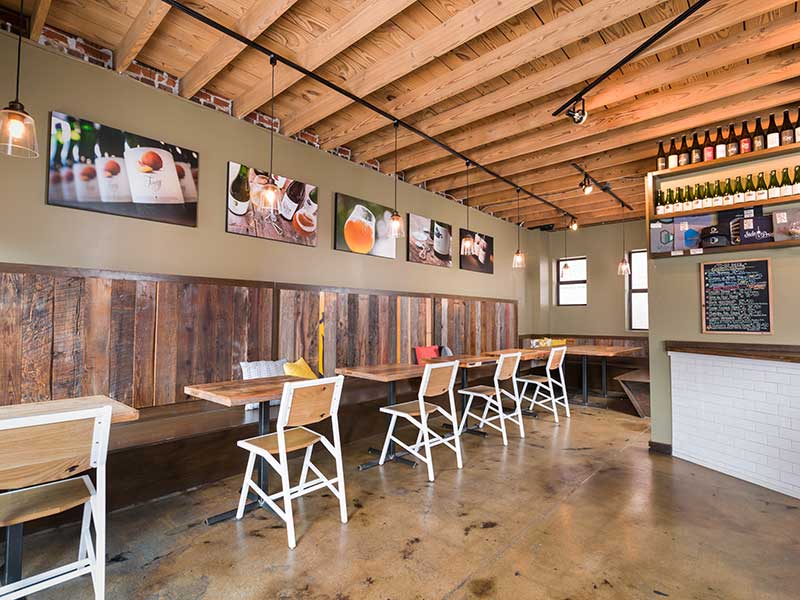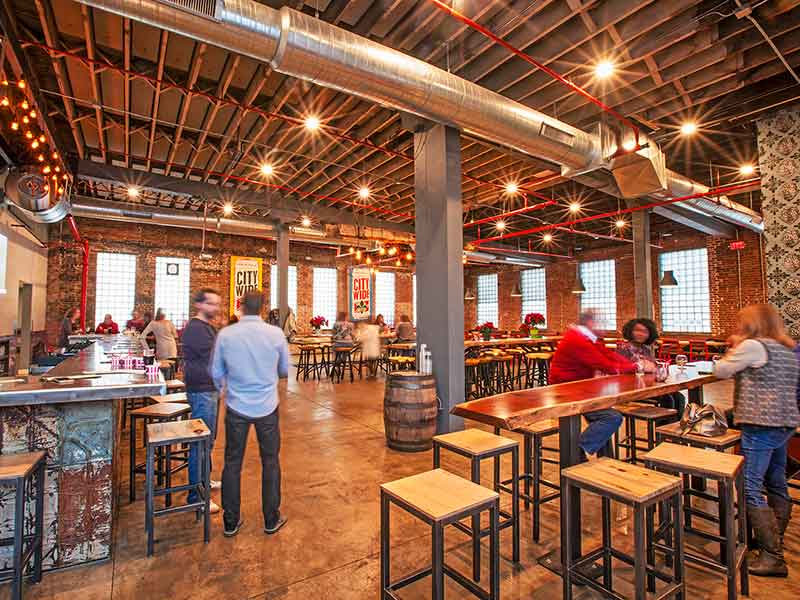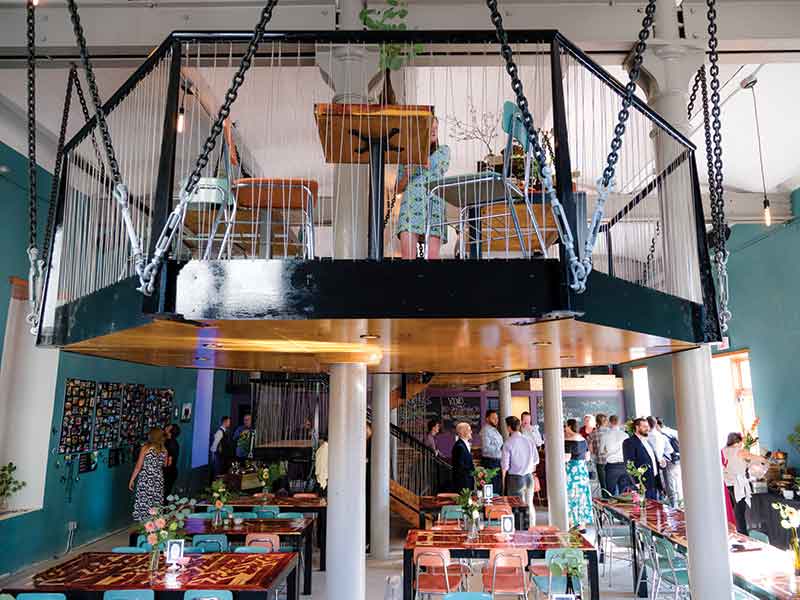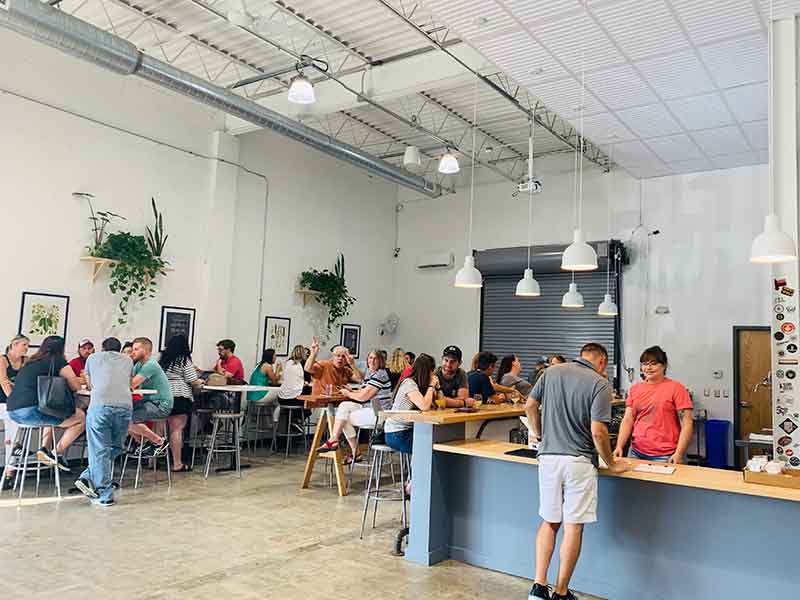In 2010, Cory King and his wife, Karen, started brewing beer in the kitchen of their Soulard apartment in St. Louis. Cory, a wine industry veteran, was working as head brewer at Perennial Artisan Ales, a local small-batch brewery, while his wife Karen was working in beer marketing. The pair channeled their passion for beer into a side project, hoping that someday they would be able to open their own brewery.
Ten years later, the couple’s Maplewood brewery, Side Project Brewing, was named the second best in the world by RateBeer, an internationally renowned beer ranking and reviewing website, beating out more than thirty thousand other breweries. The Kings also own a successful tasting room, The Side Project Cellar, which RateBeer recently named the Best Brewer Tap Room in Missouri for the fifth consecutive year. They’ve also launched a separate beer brand, called Shared.

While the state has always been a stronghold for beer—think Anheuser-Busch—the Kings’ success story exemplifies the craft beer boom in Missouri. In 2011, the number of craft breweries operating in the state was just shy of fifty. In 2018, more than double that number were making beer.
Missouri ranks twentieth in the United States for the number of craft breweries, according to the most recent data from the Brewers Association, a national organization operated by and geared toward brewers. Missouri craft brewers churned out 367,871 barrels of beer in 2018.
To fully understand why brewing has continued to thrive in Missouri, one has to go back to its roots. After Prohibition, brewing enjoyed a resurgence in the state, mostly fueled by German and European immigrants. Back then, a brewery’s plan was to expand as quickly as possible, said Pete Dulin, author of Kansas City Beer: A History of Brewing in the Heartland; KC Ale Trail; and Expedition of Thirst: Exploring Breweries, Wineries and Distilleries Across Central Kansas and Missouri. “It was about scale to make your money. The variety of beer wasn’t what it is today,” Pete says.
Fast-forward to the late 1980s and 1990s. Anheuser-Busch continued to dominate state beer sales, but craft breweries started vying for a share of the market. Boulevard Brewing Company opened a craft brewery in Kansas City in 1989. A couple of years later, Schlafly, then known as The Saint Louis Brewery, opened its brewpub and restaurant, becoming the first craft brewery to open in St. Louis since Prohibition.

St. Louis Breweries
However, craft brewers trying to open businesses in those years faced many challenges. At the time, laws and regulations for craft breweries in the state were more stringent. Tom Schlafly, the founder of Schlafly, and his partner, Dan Cotman, worked to change state legislation to brew and sell beer and run a pub. “We really paved the way for a lot of other breweries to open and have pubs here in the city,” says Wil Rogers, head of marketing at Schlafly Beer.
With more beer-friendly laws in place, more craft brewers began to open in the state, especially in St. Louis, a town with a rich brewing history and plentiful industry experience.
A background in the industry led Florian Kuplent, brewmaster and owner of Urban Chestnut Brewing Company in St. Louis, to open his own brewery. Florian, a native of Germany who studied brewing and apprenticed there, moved to New York City to work for Anheuser-Busch. He was then transferred to the company’s St. Louis headquarters to work in corporate brewing.
After arriving in St. Louis, Florian brainstormed with a friend in Anheuser-Busch marketing and sales about opening a brewery. The pair opened Urban Chestnut in January 2011 to immediate success. Later, they expanded to a larger location in The Grove neighborhood of St. Louis. Today they operate three locations, including one in Germany.
Urban Chestnut pays homage to classic brewing styles and techniques while also experimenting with new flavors. The brewery’s most popular products include a German-style Zwickel beer and an American lager called Urban Dog. St. Louis’s German roots and its history as a beer town made it the ideal place for Florian to start a brewery.
The city’s beer history has also paved the way for smaller, niche breweries such as Earthbound Brewing. Earthbound has made a name for itself through its unusual beers and business model. The brewery is 100 percent owner operated, which opens the door for more experimentation than operations with lots of different partners or outside investors involved, says Stuart Keating, head brewer and president of beer at Earthbound. “It allows us to do more experimental beer with botanical ingredients and push the envelope,” Stuart says.
An example is Earthbound’s most popular beer, the Dead Druid King Ale. The beer is based on historical tomb findings from eighth-century Bavaria. Stuart used those findings to create a recipe for the beer, which is made from oak leaf tea. It has a higher alcohol content, about 7 to 8 percent alcohol by volume (ABV), and is dark and tart. “It really blows people away,” Stuart says. “We only make it once a year because we can only go out and pick oak leaves while they’re young.”

Kansas City Breweries
While St. Louis leads the pack in Missouri in terms of beer history and the sheer number of breweries, other breweries in the state have made a name for themselves, too. Kansas City hosts newer breweries such as Alma Mader, which opened in 2019, during a pivotal time.
The United States now has close to eight-thousand craft breweries, which creates a “more mature, competitive market” for brewers, says Nick Mader, owner and head brewer at Alma Mader, located near Union Station. “You’re trying to get people’s attention with your beer. For us, a small brewery that opened in 2019, we’re making styles that are relevant for what people want and what we like to make,” Nick says.
Alma Mader mainly focuses on German and Czech-style beers. The brewery has a Czech lager faucet that it imported from the Czech Republic, which allows it to pour beers with dense, creamy heads and layered foam on top.

Nick is a native of Kansas City who worked in beer in Colorado and Seattle. He finds the city now offers a good environment for brewing and opportunities that perhaps were not available many years ago when he moved away, he says. Breweries are popping up in growing neighborhoods, including the Crossroads District, which has enjoyed more development in recent years.
The Kansas City beer community is particularly tight-knit, Nick says, with lots of industry interaction and support.
“There’s a community that forms around the brewery. The future of the beer scene now is connecting with people and creating relationships, being concerned about what’s happening in your tasting room, and selling beer directly from your tasting room. It’s all relationship-based,” Nick says.
Springfield Breweries
Kyle Jeffries, brewery liaison at Mother’s Brewing in Springfield, agrees. “Craft beer is a labor of love. Anyone who is getting into the industry and thinks they’re going to make one million dollars overnight is in for a rude awakening. If your brewery isn’t about the community that loves and supports you, you’re in for a rough ride,” Kyle says.
Mother’s Brewing got its start with that exact concept in mind. Ten years ago, founder Jeff Schrag, a Springfield native and serial entrepreneur, decided to embark on one last business venture. He looked at the two other big cities in Missouri and saw that they had hometown production. He decided to build a regional brewery in downtown Springfield.
A decade later, Mother’s Brewing focuses on canning, bottling, and distributing its beer across a wider geography. The brewery sells its beer in Missouri and surrounding states to reach the widest population possible, which differs from many craft brewers’ business model of selling across the bar.
“Craft beer is a beautiful mix of tradition and innovation.” Kyle says. “Every brewery is bringing a subtle interpretation to those classic traditions. The one thing that will always set us and other breweries apart is our beers are our own. We could be making the same style of American Pale Ale, but it will always be Mother’s because of the people here putting their time and artistry into it. Every experience is different,” Kyle says.
Outside the Cities
While Missouri’s larger cities are home to the majority of the state’s breweries, outfits such as Back Home Brewing in Ozark, Lake of the Ozarks Brewing Co. in Osage Beach, and Public House Brewing Company in Rolla have also made their marks on the scene.
“People want to have local, fresh craft beer instead of going to the store and buying craft beer made somewhere else. We’re seeing craft breweries pop up in small towns. Locals are coming out to support it,” says Pete Dulin.
Public House is a perfect example. The brewery opened in 2010 to almost instant acclaim. Owners Josh Stacy and Josh Goodridge had to close the brewpub in the first weekend because local people drank them out of beer, says head brewer Matt Burkhardt.
In 2014, Public House Brewing was approached by St. James Winery, a local vineyard that’s widely known in the state for its fruit wine. The pair formed a partnership, and St. James built a bigger production facility, opened distribution, installed a full kitchen, and created an outdoor beer garden area.
Public House now offers its beers in cans instead of bottles, a nod to a recent trend but also a shrewd business move. The brewery is located close to float rivers and outdoor activities, and many customers wanted a product that they could take with them as they explored local terrain.
Columbia is home to a vibrant beer scene with Broadway Brewery, Bur Oak Brewing Company, Logboat Brewing Company, and twenty-six-year-old Flatbranch Pub & Brewing. All four breweries welcome visitors to their facilities. Broadway Brewery and Flatbranch are both brewpubs with full-service kitchens. Bur Oak routinely holds special events at their tasting room, and Logboat’s grassy outdoor area has become arguably the most popular yard in town.
“In 2009 we were one of two microbreweries in town,” says Harry Katz, marketing director at Broadway Brewery. “It’s been amazing to be part of the growing beer scene in Missouri.”
While Columbia’s beer scene hasn’t experienced as much growth as Springfield’s, Harry says it’s keeping pace with the rest of the state.
Beyond Beer
Mothers Brewing in Springfield this year for the first time is brewing a nonbeer product. Its Ready alcoholic seltzer, which launched in March 2020 and comes in fruity flavors such as cherry limeade and blackberry lemon, is a nod to a recent trend of more fruit-forward beers.
“You have to stay current and contemporary in this industry. When you look at overall trends of what people are enjoying, drinking, and buying, there are a lot of people for various reasons who aren’t beer drinkers. One of our core missions is to brew products that bring people together to have fun. Our hard seltzer furthers that mission,” says Kyle.
WellBeing Brewing in St. Louis concentrates solely on nonalcoholic beer. The company got its start when owner Jeff Stevens decided to quit drinking after years of working in the beer and spirits industry. “I knew from firsthand experience how underserved people who don’t drink alcohol are.” Jeff says. “As the explosion of craft beer happened, I thought, why do I have to drink O’Doul’s all the time?”
WellBeing makes its nonalcoholic beer with a machine imported from Germany. The company takes high quality, fully fermented beer and puts it in a vacuum, which lowers the temperature to take out the alcohol. Companies would have to boil beer to achieve the same effect, Jeff says, which could adversely affect flavor.
“Missouri is a microcosm of the United States. You have a variety of neighborhoods, urban and rural. You have different ecosystems and cultures at play. A brewery should be an expression of the culture it grows out of. That’s part of the reason we have so many excellent breweries in the state,” says Stuart from Earthbound Brewing.
Although many Missouri breweries sell their products in grocery and liquor stores across the state, tasting rooms are closed due to the spread of Covid-19. Check the website of the brewery you’re thinking about visiting to see if they offer curbside or delivery orders. Plus, visit MissouriLife.com for a complete list of breweries in the state.
Tips from Pete Dulin, author of Kansas City Beer: A History of Brewing in the Heartland; KC Ale Trail; and Expedition of Thirst: Exploring Breweries, Wineries and Distilleries Across Central Kansas and Missouri, for tasting at a craft brewery taproom.
1. Don’t be intimidated. “Most of the people behind the bar are knowledgeable and happy to help. Ask lots of questions if you don’t understand the style or differences between beers.”
2. Care to share. “Start by sharing sensory notes to help the bartender guide you. Tell the bartender what you’re in the mood for: light and crisp, medium-bodied, or dark and robust? Roasted notes with chocolate and coffee, citrusy, piney and herbal, floral, fruity, bitter, sweet, or in between?”
3. Don’t fight; flight. “Flights are another way to experiment. If you go to a craft beer taproom and can’t decide on one, a lot of places will let you order a flight of beer, or three to five small pours, and then you can sample each one. It’s a pretty inexpensive way to explore and be adventurous. Then you’re not committed to a full beer.”
4. Taste and compare. “Over time, you can taste and compare your sensory impression with the style and description of the beer. You will develop more confidence in your beer knowledge and personal preferences.”
Related Posts
New Craft Beer Commemorates the Katy
Sudwerk Brewing Co.’s Hindman Junction Session IPL celebrates the Katy Trail’s 30th anniversary and benefits a mid-Missouri charity.
The Craft of Pipe Making
Learn how Missouri Meerschaum makes the beloved corn cob pipes that Washington, Missouri is known for.
Notley Hawkins Documents the Flooding in Mid-Missouri
Photographer Notley Hawkins captured images of the historic flooding in mid-Missouri with his camera and drone. Plus, learn how you can assist in relief efforts.



